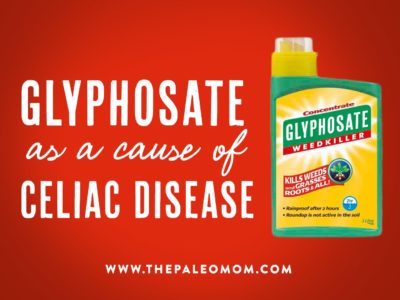Although science has brought us closer to understanding how celiac disease occurs, what genetic and environmental factors make us susceptible, and how the disease can affect our long-term health and wellbeing, one big question remains: why is celiac disease becoming more and more widespread?
According to data from 2009, the prevalence of celiac disease in America increased four-fold over the course of the previous 50 years. Similar trends have been found in Europe (celiac rates in Finland doubled between 1978-1980 and 2000-2001). And, these increases can’t be explained by diagnostic improvements alone. People really are developing celiac disease more frequently than in previous decades!
Because celiac disease is closely linked with changes in the gut microbiome and the integrity of the intestinal barrier, and because genetics alone can’t explain why more people are developing celiac disease than ever before, some scientists have looked to environmental exposures (especially ones that have changed or increased during the last century) as a possible explanation for celiac disease’s rise. In late 2013, a paper came out proposing that glyphosate—the active ingredient in Monsanto’s weed killer Roundup—may be one such culprit.
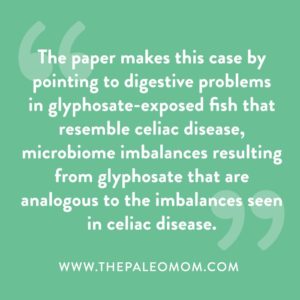 The paper makes this case by pointing to digestive problems in glyphosate-exposed fish that resemble celiac disease; microbiome imbalances resulting from glyphosate that are analogous to the imbalances seen in celiac disease; an inhibition of cytochrome P450 enzymes by glyphosate that leads to some of the same characteristics as celiac disease; glyphosate’s ability to chelate certain minerals and deplete certain amino acids that happen to be the same ones often found deficient among celiacs; and a striking parallel between the increased health risks associated with glyphosate exposure and the increased health risks associated with celiac disease (including non-Hodgkins lymphoma, miscarriages, birth defects, and infertility). Ultimately, the authors conclude, glyphosate appears to make wheat more immunogenic.
The paper makes this case by pointing to digestive problems in glyphosate-exposed fish that resemble celiac disease; microbiome imbalances resulting from glyphosate that are analogous to the imbalances seen in celiac disease; an inhibition of cytochrome P450 enzymes by glyphosate that leads to some of the same characteristics as celiac disease; glyphosate’s ability to chelate certain minerals and deplete certain amino acids that happen to be the same ones often found deficient among celiacs; and a striking parallel between the increased health risks associated with glyphosate exposure and the increased health risks associated with celiac disease (including non-Hodgkins lymphoma, miscarriages, birth defects, and infertility). Ultimately, the authors conclude, glyphosate appears to make wheat more immunogenic.
The paper has been cited as evidence that Roundup is more harmful than we’ve been led to believe, and that glyphosate is directly contributing to health problems we’ve been facing at an increasing rate. But, the paper also garnered criticism for lacking a sound scientific basis, for misrepresenting certain data, and for mistaking correlation for causation.
It’s true that health-oriented communities (including Paleo!) can sometimes be so eager to implicate GMOs and manmade chemicals in our modern disease epidemic that we don’t critically examine papers like this one. But, it’s also true that many of the rebuttals for this particular paper were produced by individuals or organizations affiliated with bioengineering, who may have a vested interest in defending Roundup. That means we should go straight to the science to find out the truth for ourselves. Does the glyphosate-celiac theory hold up when we fact-check the evidence? Or are the criticisms against it legitimate? Let’s take a look!
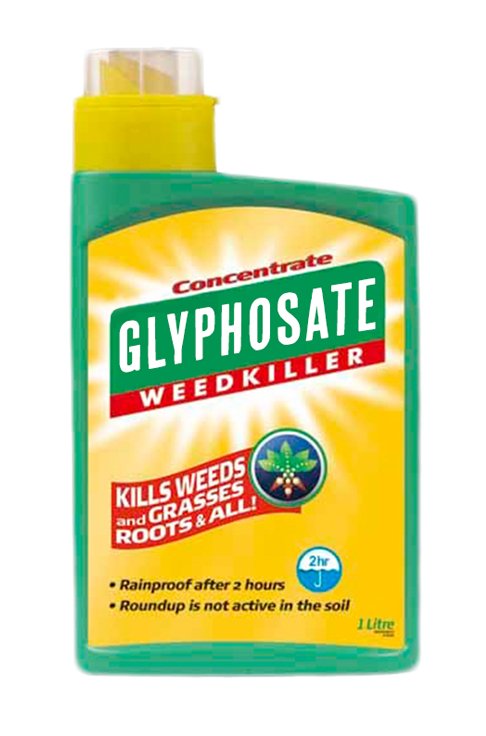
What is Glyphosate?
Glyphosate is a broad-spectrum herbicide that can kill both grasses and leafy weeds. It works by inhibiting an enzyme (5-enolpyruvylshikimic acid-3-phosphate synthase, or EPSP synthase) in plants that’s needed to synthesize the amino acids tyrosine, tryptophan, and phenylalanine (which are essential for plant growth). The pathway this affects (the shikimic pathway) doesn’t exist in animals, which is part of why glyphosate is considered to have low toxicity in animals. In the US, glyphosate has been used for over 40 years and is used mostly to kill weeds that interfere with agricultural crops (typically corn, soy, and canola).
Glyphosate and Fish
To support the idea that glyphosate might contribute to celiac disease by reducing the breakdown of wheat proteins in the stomach (leaving larger fragments to pass through the gut, potentially trigger autoimmunity, and damage the intestines), the paper’s authors cite a 2009 study of carnivorous fish that were exposed to glyphosate. The fish were put into water that contained 4mg/L of glyphosate, which is the concentration typically used by farmers to control aquatic weeds. The study found that glyphosate triggered a number of detrimental effects throughout the fishes’ digestive systems, including a reduction in protease, lipase, and amylase activity (so they can’t digest their food efficiently); disruptions of the mucosal folds and microvilli structure in the intestinal wall; and exaggerated mucin secretion in the intestine—all of which are reminiscent of celiac disease.

However, as one critic pointed out, this fish study used a commercial product from India called Excel Mera-71, which contains not only glyphosate, but also non-ionic and cationic surfactants that are known to injure fish. (In the US, herbicides that are designed for use on aquatic weeds don’t contain surfactants for this very reason.) And, the effects described in the fish study that were attributed to glyphosate happen to be the same effects that occur when fish are exposed to surfactants. Because the study didn’t contain a control group that used glyphosate but no surfactants, it’s impossible to know which of the two was causing intestinal damage to the fish (but, since glyphosate has been found to be non-toxic to fish in other studies, it’s probably the surfactants!). In addition, the herbicide concentrations used were impossibly high when we consider that drift or runoff exposure to glyphosate in an aquatic environment would be much lower than the undiluted concentrations sprayed directly on plants. These issues make this particular study unreliable for supporting a glyphosate-celiac disease link.
Nutrivore Weekly Serving Matrix
An easy-to-use and flexible weekly checklist
to help you maximize nutrient-density.
The Weekly Serving Matrix is very helpful! I’ve been eating along these lines but this really helps me know where to focus vs. which foods serve a more secondary role. It’s super helpful and has taken a lot of worry out of my meal planning. Thanks!
Jan
Glyphosate and Gut Bacteria
The authors of the glyphosate-celiac disease paper explain that glyphosate has been shown to disrupt bacterial colonies in a variety of animal species, including poultry, cattle, and pigs (using mostly in vitro studies). These disruptions can consist of increasing the ratio of pathogenic bacteria to helpful microbes, promoting a reduction of Bifidobacteria, Lactobacillus, and Enterococcus while supporting an increase in Salmonella and Clostridium (which are resistant to glyphosate). Indeed, celiac disease is associated with a reduction of these same beneficial bacteria and an increase in numerous pathogenic bacteria (including Salmonella and Clostridium, but also Bacteroides, Staphylococcus, and Shighella).
However, there are a few problems with this argument. One, the correlation between changes in bacterial levels found in vitro in glyphosate studies and in celiac disease doesn’t prove that glyphosate is the causative variable. Especially when we consider the complex relationship between celiac disease and the microbiome, as well as the many other antimicrobial and disinfectant exposures we receive daily that may be more significant than very small amounts of glyphosate residue on food.
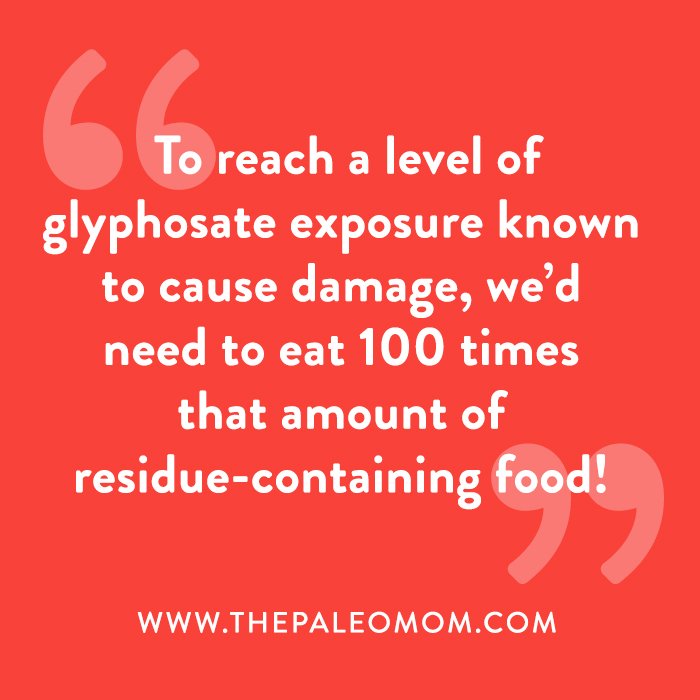
Two, we have no evidence that the glyphosate concentrations from Roundup-sprayed crops (levels we could feasibly experience in real life, opposed to the impossible exposures used in many studies) have any effect in other animals’ microbiomes, much less in humans. Studies finding an effect of glyphosate on gut bacteria use levels that would be next to possible to attain from our diet. By some calculations, we would need to eat over 60 lbs. of produce with the highest legal level of glyphosate residue, every single day, in order to reach an intake of 2 mg of glyphosate per kilogram of body weight (which is considered the “still safe” level by the EPA). To reach a level of glyphosate exposure known to cause damage, we’d need to eat 100 times that amount of residue-containing food!
Now, this doesn’t necessarily mean that glyphosate is benign to the human microbiome. We just don’t have the data needed to confirm (or even suggest) that realistic levels of glyphosate exposure in humans causes the same type of dramatic microbiome changes seen in celiac disease. And, if it does, that these changes are directly related to celiac disease and are unique to glyphosate among the other microbial agents we’re frequently exposed to. This is one area that deserves much more research!
Glyphosate and CYP Enzyme Impairment
Another argument linking glyphosate with celiac disease involves the effects of glyphosate on cytochrome P450 (CYP) enzymes, which are essential for detoxifying many compounds in the liver. The authors argue that glyphosate has been shown to suppress CYP enzymes in both plants and some animals (such as the rat), and that many conditions associated with celiac disease (such as impaired gallbladder bile acid production and biliary cirrhosis) are related to impaired CYP enzyme activity. They add that the association between celiac disease and non-alcoholic fatty liver could be due to impaired CYP enzymes reducing the liver’s ability to export cholesterol sulfate through the bile acids. And, because of the role of CYP enzymes in detoxifying xenobiotics, suppression of these enzymes might increase the damage caused by a variety of environmental toxins that we face every day.
If true, glyphosate suppressing CYP enzymes would be a legitimate concern, and could confirm that this chemical is toxic to mammals. But, there’s just one problem! The authors of this paper cite only one study as evidence that glyphosate reduces CYP activity in animals (rats), and the doses that study used were between 150 and 250 times higher than the EPA limit for humans (500 mg/kg for the first four days of the study and 300 mg/kg for the remainder of the two weeks; the upper limit for humans is 2 mg/kg). At such high exposures, evidence of toxicity becomes more likely, and the results can’t translate to the significantly lower exposures that humans get from food.
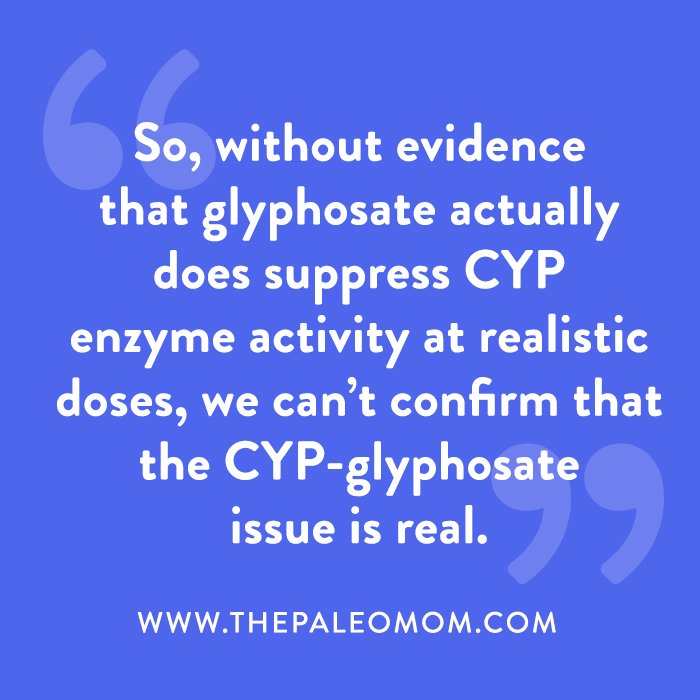
What’s more, another study that the authors didn’t cite shows that glyphosate doesn’t inhibit CYP enzymes in humans.
So, without evidence that glyphosate actually does suppress CYP enzyme activity at realistic doses (there’s more evidence suggesting the exact opposite is true!), we can’t confirm that the CYP-glyphosate issue is real, much less relevant to celiac disease. (It’s also worth noting that a variety of medications and even naturally occurring substances in some foods, such as furanocoumarins in grapefruit, also inhibit CYP enzymes. So, if glyphosate contributed to celiac disease through CYP inhibition, so would many pharmaceuticals and some foods we generally deem healthy.)
Glyphosate and Nutrient Deficiencies
Yet another proposed parallel between glyphosate exposure and celiac disease is the presence of specific nutrient deficiencies, including iron, molybdenum, and selenium. The authors of this paper suggest that glyphosate’s ability to chelate these minerals could help explain why people with celiac disease tend to be deficient in them. However, malabsorption due to damaged intestinal villi is a more likely explanation for the micronutrient deficiencies that accompany celiac disease, especially because we don’t actually have evidence that glyphosate chelates these minerals within our bodies under real-life conditions.
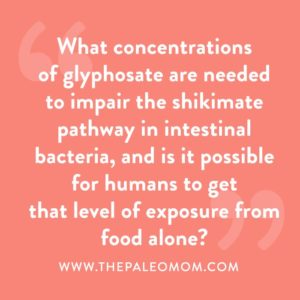 The authors also note that glyphosate’s ability to disrupt the synthesis of tryptophan and tyrosine in plants and gut bacteria could have relevance for humans. Although humans lack the shikimate pathway that causes glyphosate to be lethal to plants, bacteria possess it! So, glyphosate that makes it into our gut could theoretically impair that pathway in our gut bacteria, leading to a reduced synthesis of certain micronutrients and amino acids (including tryptophan). As a matter of fact, the paper’s authors note that children with untreated celiac disease have much lower ratios of tryptophan relative to large neutral amino acids in the blood, and that this appears due to a problem with synthesis rather than absorption.
The authors also note that glyphosate’s ability to disrupt the synthesis of tryptophan and tyrosine in plants and gut bacteria could have relevance for humans. Although humans lack the shikimate pathway that causes glyphosate to be lethal to plants, bacteria possess it! So, glyphosate that makes it into our gut could theoretically impair that pathway in our gut bacteria, leading to a reduced synthesis of certain micronutrients and amino acids (including tryptophan). As a matter of fact, the paper’s authors note that children with untreated celiac disease have much lower ratios of tryptophan relative to large neutral amino acids in the blood, and that this appears due to a problem with synthesis rather than absorption.
The big question mark here is this: what concentrations of glyphosate are needed to impair the shikimate pathway in intestinal bacteria, and is it possible for humans to get that level of exposure from food alone? We don’t currently have answers for this, so for now, it’s an interesting theory that hasn’t been confirmed!
Take-Home Message
The steady rise in celiac prevalence is a major concern, and there’s no harm in exploring different theories about what’s driving those rising numbers (after all, science is all about making observations, forming hypotheses, and then testing them in order to advance our knowledge and understanding of the world!).
That being said, a causative role for glyphosate in celiac disease is iffy at best. The paper in question compiles a number of potential arguments that may seem compelling at first glance, but that (with a few exceptions) generally don’t hold up to closer examination. This doesn’t mean that glyphosate is definitely harmless for us (the preliminary evidence would suggest that we should be taking measures to limit our exposure), or that a link with celiac disease is out of the question; just that we don’t currently have the evidence needed to confidently claim that they’re linked!
This article is certainly not in defense of glyphosate use as an herbicide. We know that dietary exposure is sufficient for measurable amounts to get into our bodies: one study showed that 44% of city dwellers in 18 countries in Europe had detectable glyphosate residues in their urine, despite Europe’s more aggressive campaign against GMO foods. No comparable study has ever been conducted in the USA. And we know that there are multiple mechanisms through which glyphosate may negatively impact our health (even if one of those ways isn’t causing celiac disease). Instead, I want to emphasize that the celiac disease almost certainly has multiple contributors to its pathogeneisis; glyphosate may or may not be one of them.
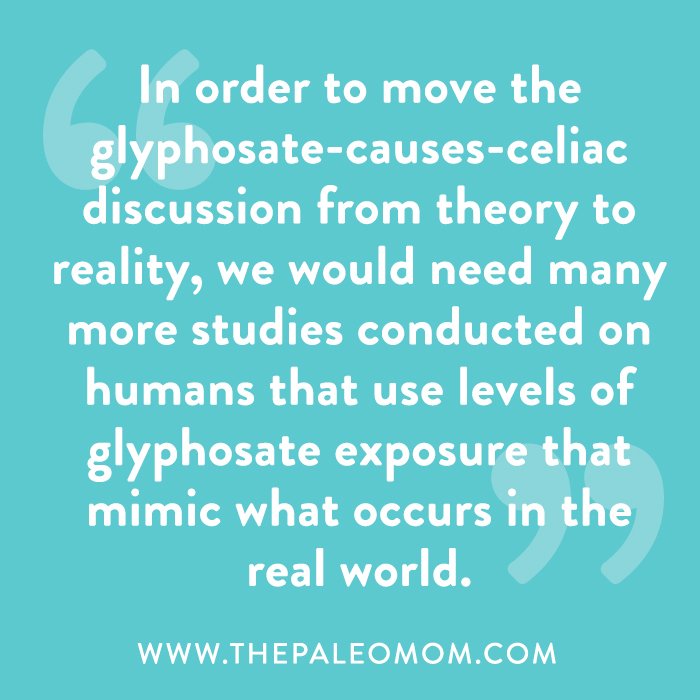
In order to move the glyphosate-causes-celiac discussion from theory to reality, we would need many more studies conducted on humans that use levels of glyphosate exposure that mimic what occurs in the real world. In vitro studies, animal studies, and/or studies with extremely high glyphosate dosing can be useful to help generate ideas and inform future research directions, but they can’t serve as evidence that glyphosate contributes to celiac disease in humans. But, while we wait for more relevant research to be conducted, there’s no harm in avoiding wheat (rather, there may be plenty of benefits; ) and in choosing, when possible, food grown without the use of aggressive herbicides and pesticides!
Citations
Cenit MC, et al. “Intestinal Microbiota and Celiac Disease: Cause, Consequence or Co-Evolution?” Nutrients. 2015 Aug; 7(8): 6900–6923.
Hietanen E, et al. “Effects of phenoxyherbicides and glyphosate on the hepatic and intestinal biotransformation activities in the rat.” Acta Pharmacol Toxicol (Copenh). 1983 Aug;53(2):103-12.
Hoppe H-W. Determination of Glyphosate residues in human urine samples from 18 European countries; 2013. Report Glyphosate MLHB-2013-06-06. Medical Laboratory Bremen, Haferwende 12, 28357 Bremen, Germany, March.
Kruger M, et al. “Glyphosate suppresses the antagonistic effect of Enterococcus spp. on Clostridium botulinum.” Anaerobe. 2013 Apr;20:74-8. doi: 10.1016/j.anaerobe.2013.01.005. Epub 2013 Feb 6.
Lamb DC, et al. “Glyphosate is an inhibitor of plant cytochrome P450: functional expression of Thlaspi arvensae cytochrome P45071B1/reductase fusion protein in Escherichia coli.” Biochem Biophys Res Commun. 1998 Mar 6;244(1):110-4.
Lohi S, et al. “Increasing prevalence of coeliac disease over time.” Aliment Pharmacol Ther. 2007 Nov 1;26(9):1217-25.
Lu W, et al. “Genome-wide transcriptional responses of Escherichia coli to glyphosate, a potent inhibitor of the shikimate pathway enzyme 5-enolpyruvylshikimate-3-phosphate synthase.” Mol Biosyst. 2013 Mar;9(3):522-30. doi: 10.1039/c2mb25374g. Epub 2012 Dec 18.
McLaughlin LA, et al. “Functional Expression and Comparative Characterization of Nine Murine Cytochromes P450 by Fluorescent Inhibition Screening.” DRUG METABOLISM AND DISPOSITION. 2008;36(7):1322-1331.
Rubio-Tapia A, et al. “Increased prevalence and mortality in undiagnosed celiac disease.” Gastroenterology. 2009 Jul;137(1):88-93. doi: 10.1053/j.gastro.2009.03.059. Epub 2009 Apr 10.
Samsel A & Seneff S. “Glyphosate, pathways to modern diseases II: Celiac sprue and gluten intolerance.” Interdiscip Toxicol. 2013 Dec;6(4):159-84. doi: 10.2478/intox-2013-0026.
Senapati T, et al. “Observations on the effect of glyphosate based herbicide on ultra structure (SEM) and enzymatic activity in different regions of alimentary canal and gill of Channa punctatus (Bloch).” Journal of Crop and Weed. 2009;5(1):236-245.
Shehata AA, et al. “The effect of glyphosate on potential pathogens and beneficial members of poultry microbiota in vitro.” Curr Microbiol. 2013 Apr;66(4):350-8. doi: 10.1007/s00284-012-0277-2. Epub 2012 Dec 9.

